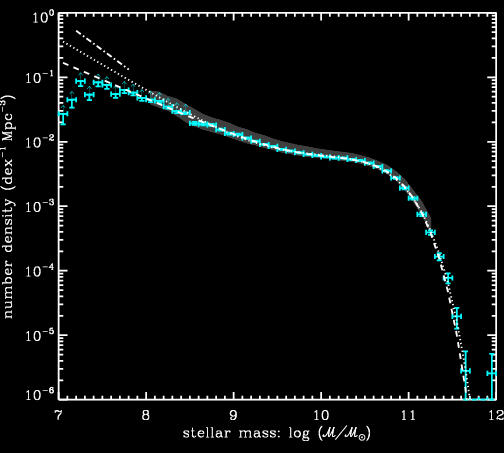On the galaxy stellar mass function, the mass-metallicity relation,
and the implied baryonic mass function
Baldry, Glazebrook & Driver 2008,
published in MNRAS, Vol. 388, pp. 945-959 (link:
ADS).
Abstract
A comparison between published field galaxy stellar mass functions (GSMFs)
shows that the cosmic stellar mass density is in the range 4--8 per cent of
the baryon density (assuming Omega_b = 0.045). There remain significant
sources of uncertainty for the dust correction and underlying stellar
mass-to-light ratio even assuming a reasonable universal stellar initial mass
function. We determine the z < 0.05 GSMF using the New York University -
Value-Added Galaxy Catalog sample of 49968 galaxies derived from the Sloan
Digital Sky Survey and various estimates of stellar mass. The GSMF shows clear
evidence for a low-mass upturn and is fitted with a double Schechter function
that has alpha_2 =~ -1.6. At masses below ~ 10^8.5 Msun, the GSMF may be
significantly incomplete because of missing low surface-brightness galaxies.
One interpretation of the stellar mass-metallicity relation is that it is
primarily caused by a lower fraction of available baryons converted to stars
in low-mass galaxies. Using this principal, we determine a simple relationship
between baryonic mass and stellar mass and present an `implied baryonic mass
function'. This function has a faint-end slope, alpha_2 =~ -1.9. Thus, we
find evidence that the slope of the low-mass end of the galaxy mass function
could plausibly be as steep as the halo mass function. We illustrate the
relationship between halo baryonic mass function --> galaxy baryonic mass
function --> GSMF. This demonstrates the requirement for peak galaxy formation
efficiency at baryonic masses ~ 10^11 Msun corresponding to a minimum in
feedback effects. The baryonic-infall efficiency may have levelled off at
lower masses.
Data:
- Field galaxy stellar mass function
as per Figure 6:
binned function data.
-
Notes:
- IMFs of Kroupa (2001) or Chabrier (2003) were assumed.
- H0 = 70 km/s/Mpc was assumed.
- The SDSS NYU-VAGC low-z
DR4 sample was used.
- The max number densites were multiplied by 1.13,
which represents a correction from the z < 0.05 volume
to the z < 0.1 volume based on number densities of bright galaxies.
- The log stellar mass < 8.5 data points
should be regarded as lower limits because of surface-brightness
incompleteness (certainly for log mass < 8).
- The stellar mass estimates used were by
A. Gallazzi [1,
2],
K. Glazebrook,
G. Kauffmann [1,
3],
B. Panter [4]
(and their collaborators).
- The stellar M/L were applied to Petrosian magnitudes,
some correction could be used to correct to total magnitudes
(~ factor 1.05 to 1.1 on average). For individual galaxies,
Petrosian magnitudes recover 0.8 to 0.99 of the total flux.
- How well can population synthesis correct for dust attenuation?
Driver et al.
[5,
6]
advocate a larger correction than likely accounted
for by the above M/L estimates, some correction could
be used to account for completely obscured stellar populations
(upto ~ factor 1.2).
|

|
Gas-to-stellar mass ratios as per Figure 11:
compilation data.
Ivan Baldry, written 2008 April 20.
Links: - to my home page;
to my research page;
list of publications.
